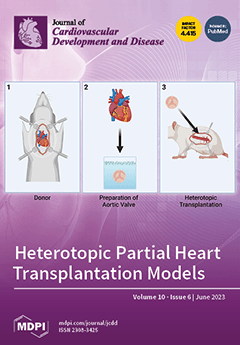(1) Background: The presence of restrictive left ventricular diastolic filling pattern (LVDFP) is associated with an unfavorable prognosis in many cardiac diseases, but few data are available on the prognostic implications of this pattern in patients with dilated cardiomyopathy (DCM). We aimed to
[...] Read more.
(1) Background: The presence of restrictive left ventricular diastolic filling pattern (LVDFP) is associated with an unfavorable prognosis in many cardiac diseases, but few data are available on the prognostic implications of this pattern in patients with dilated cardiomyopathy (DCM). We aimed to establish the main prognostic predictors at the 1- and 5-year follow-ups in DCM patients and the value of restrictive LVDFP in increasing morbidity and mortality. (2) Methods: A prospective study of 143 patients with DCM divided in non-restrictive LVDFP group (95 patients) and restrictive group (47 patients). The patients were evaluated at a 5-year follow-up through an in-patient visit during the pre-pandemic period and hybrid methods (face-to-face, teleconsultation and home monitoring with a telemedicine application) during the pandemic period. Statistical analysis compared the two groups in terms of NYHA class, quality of life, hospitalizations/emergency department (ED) visits due to HF exacerbation and total mortality. (3) Results: The mortality rate in the restrictive group was markedly higher than that in the non-restrictive group at 1 year (17.02% vs. 10.59%, respectively,
p < 0.05) and at 5 years (68.08% vs. 50.53%,
p < 0.05). In the restrictive group, hospitalizations/ED visits due to HF decompensations at 1 year were significantly higher (85.11% vs. 57.89%,
p < 0.05), with hospitalizations for ventricular arrhythmia being almost three times higher (21.28% vs. 7.37%, respectively,
p < 0.05). The percentage of patients with a favorable evolution (in terms of NYHA class and quality of life) at the 1- and 5-year follow-ups were higher in the non-restrictive LVDFP group. The main prognostic predictors in patients with DCM at the 1-year follow-up were: restrictive LVDFP, age > 75 years, markedly dilated LV, comorbidities (DM, COPD), 2nd-degree mitral regurgitation and severe pulmonary hypertension (
p < 0.05). (4) Conclusions: At the 1- and 5-year follow-ups, the presence of the restrictive LVDFP in DCM patients was independently associated with a poor prognosis, being the best clinical predictor for unfavorable evolution, after adjustment for other well-established predictive parameters in DCM patients.
Full article






